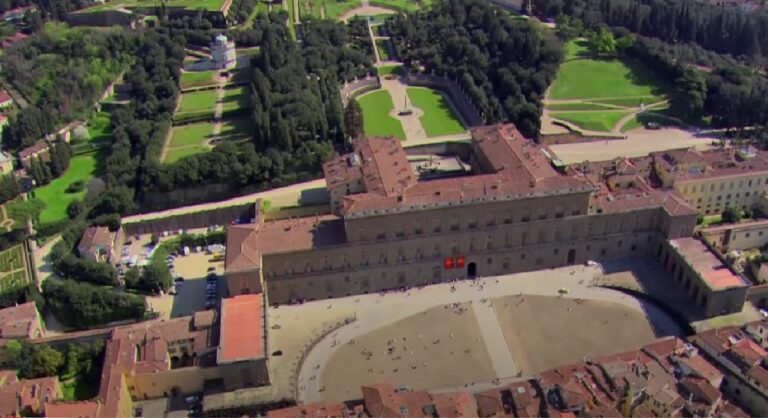Pitti Palace & Boboli Gardens: Florence’s Regal Retreat of Art and Nature
Nestled in the heart of Florence’s Oltrarno district, the Pitti Palace (Palazzo Pitti) and Boboli Gardens (Giardini di Boboli) form one of Italy’s most majestic cultural complexes. Together, they offer a journey through Renaissance architecture, royal opulence, and landscape artistry, making them must-see landmarks for anyone exploring Florence.
Pitti Palace: From Banker’s Mansion to Medici Majesty
Originally commissioned in 1458 by the ambitious Florentine banker Luca Pitti, the palace was intended to rival the grandeur of the Medici residences. Ironically, it was the Medici family who purchased the property in 1549, transforming it into the primary residence of the Grand Dukes of Tuscany.
Architectural Grandeur
The Renaissance-style facade of the Pitti Palace is both imposing and elegant, stretching over 204 meters—longer than two football fields. Over the centuries, architects like Bartolomeo Ammannati and Giorgio Vasari expanded the palace, adding courtyards, wings, and ornate interiors that reflect the evolving tastes of Florence’s ruling elite.
🖼️ Museums Inside the Pitti Palace
Today, the palace is a treasure trove of Florentine art and history, housing several world-class museums:
| 🏛 Museum | 🖌️ Highlights |
|---|---|
| Palatine Gallery | Masterpieces by Raphael, Titian, Rubens, and Tintoretto, displayed in lavish state rooms |
| Royal Apartments | Lavishly decorated rooms once used by the Medici and later the Italian royal family |
| Gallery of Modern Art | Italian works from the 18th to early 20th centuries, with a focus on Tuscan painters |
| Museum of Costume and Fashion | Over 300 years of fashion history, from courtly gowns to modern couture |
| Treasury of the Grand Dukes | Formerly the Silver Museum, showcasing jewelry, rock crystal, and precious artifacts |
Each museum offers a unique lens into Florence’s artistic legacy, making the Pitti Palace a cultural powerhouse that rivals even the Uffizi Gallery.
Boboli Gardens: A Living Canvas of Renaissance Landscape Design
Sprawling behind the palace, the Boboli Gardens cover over 45,000 square meters of meticulously designed green space. Commissioned by Eleonora di Toledo, wife of Cosimo I de’ Medici, the gardens were laid out in the 16th century and became a prototype for Italian-style gardens across Europe.
Design & Features
The gardens blend formal symmetry with natural beauty, offering a serene escape from the city’s bustle. Key highlights include:
- Amphitheater: Once used for courtly performances, framed by ancient statues and greenery.
- Fountain of Neptune: A dramatic centerpiece featuring the sea god with his trident.
- Fountain of the Ocean: A sculptural marvel surrounded by mythological figures.
- Grotta del Buontalenti: A whimsical grotto adorned with stalactites, statues, and surreal frescoes.
- Kaffeehaus: A Rococo-style pavilion offering panoramic views of Florence’s rooftops and the Arno River.
Why Visit the Pitti Palace and Boboli Gardens?
Whether you’re an art lover, history enthusiast, or nature seeker, this complex offers a multi-sensory experience. From the masterpieces of the Palatine Gallery to the tranquil paths of Boboli, it’s a place where Florentine elegance meets Renaissance innovation.
SEO Keywords to Include
To boost visibility and attract organic traffic, consider integrating these keywords:
Primary Keywords
- Pitti Palace Florence
- Boboli Gardens Florence
- Palazzo Pitti museums
- Florence Renaissance architecture
Secondary Keywords
- Palatine Gallery Raphael
- Medici royal apartments
- Costume and Fashion Museum Florence
- Boboli Gardens fountains and statues
Long-Tail Keywords
- What to see at Pitti Palace Florence
- History of Boboli Gardens
- Best museums in Florence Italy
- Italian Renaissance garden design

